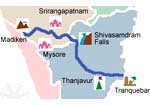


|
|
 |
| HOME | TRAVEL | TRAVELOG | ||

The Call of the Cauvery ... following the course of a river
Bill Aitken
The ignorance of the North Indian of the Southern facts of life explains why Hindi can never compete. You do not give up an ancient, devotional and literary language in favour of modern unmusical upstart! Even the suggestion of the South ever adopting Hindi is an insult only the boorish Northerner could be unaware of.
Why this epic germane to the Cauvery is because the story is set on its banks at the ancient port town on Kaveripoompattinam. Known to the Romans whose coins were once used as legal tender (just as Roman soldiers were used on sentry duty at the gates of some south Indian cities) this resort was referred to as "Cauvery emporium" to indicate the wealth of its trade. Indeed the Roman senate complained bitterly that the gold of the empire was being drained by the love of luxury originating from the Coromandal coast -- exotic animals, spices and luxury textiles. Thus the artistic skills f the "Cholas were a contributory factor to the fall of Rome! Walk along the Coromandal coast and you get an extraordinary feel of the Tamil outward-bound instinct, so different from the North Indian's fear of kala pani. In the south of the delta is the Portuguese inspired shrine of the Virgin at Velankani now saying mass in Tamil. Higher along the coast is Nagore a great centre of Muslim mysticism. Then comes Karaikal which was once a French port and the road signs still imitate the blue enamel plaques of Paris. At Tarangambade, formerly Tranquebar, you find Dutch and Danish influences -- all part of this sea going culture that made the Cholans the most adventurous of all early Indians. Poompuhar the site of the great emporium and epic of the ancient Tamils is the climax not just to the culture of the Coromandal coast but to the voyage of the Cauvery. Here she meets the sea and a statue of the goddess appears to rule the waves. It is however Kannagi. The image of the Cauvery is a gentler aspect of the feminine where their daughter of the gods and the wife of the Rishi Agustyamuni is shown emptying her water pot. She chose to come in the form of a river goddess so she could bless more people and the experience of the whole course of the river is one of physical bounty.
No serious planning has been done it seems since the Cholan king, Karaikal nearly 2000 years ago lined 100 kilometres of the delta streams to foster better harvests. Anicut is further evidence of ancient care for water management and medieval works of a smaller kind can be found in Karnataka. To see the descendants of the Cholas on the shore lashing their katamarans for the daily catch is a splendid throwback to the glory of one Indian dynasty that welcomed challenge and did not see the real world as maya. Incidentally it was at Srirangam that Ramanuja modified Shankarcharya's doctrine of maya to allow the world affirming sensibilities of the Tamil to celebrate nature as a real object of worship instead of as a nebulous spirit. I was particularly happy to see the fishermen playing out their long red nets for this very scene is captured in early Tamil literature. The bustle, expertise and fearlessness of the Coromandal sailor on his unsinkable craft is something to see. The poetry of some 2000 years still comes alive where the Cauvery meets the sea, and then the reason why the Tamil takes such pride in his language hits you. It has outlived both Kalidas's description of the Yamuna joining the Ganga at Prayag and Homeric Greek's homage to the wine-dark sea. Courtesy Sanctuary Features Map by Dominic Xavier. Photographs courtesy Government of India Tourism and Karnataka Tourism web sites
|
|
| Back | |
|
|
|
|
HOME |
NEWS |
BUSINESS |
CRICKET |
MOVIES |
CHAT
INFOTECH | TRAVEL | LIFE/STYLE | FREEDOM | FEEDBACK |
|